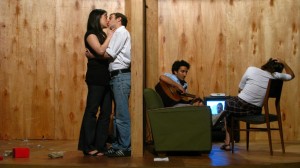Earth Activist Training with Starhawk and Friends
Cazadero, California January 7-21, 2012
From Doomsday to Bloomsday
by Holly Sisson
Our world is changing at an ever-increasing rate in response to global crises from hunger and war to the misappropriation of Earth’s natural resources. There are growing numbers of people being awakened by the effects of rapid globalization and the materialization of global warming. Our natural systems are acutely out of balance giving way to maladaptive addictions of anything from artificial sweeteners to the reliance on an unsustainable credit-based macro-economy that we have instituted at the cost of our local human communities. Trust is a phenomenon left for inter-dependent communities that see through the political idiom “every man for himself” as the illusory ambition it is. The fear induced by these maladaptive systems is reflected in mass media from network news to the film industry depicting zombie invasions and apocalypses.
Fortunately, finding problem with the current system is only the beginning to a revolutionary solution.
Earth Care, People Care, Fair Share
Respected globally for her work in non-violent communication and Earth-based spirituality, Starhawk (http://www.starhawk.org/) is one of the leaders of a growing revolution re-envisioning how we relate to each other and the natural systems of the Earth that are vital in sustaining life as we would like to know it once again. Her two week permaculture design course “Earth Activist Training” (EAT) skillfully weaves together the traditional science and philosophy of the movement’s founder Bill Mollison (http://www.scottlondon.com/interviews/mollison.html) with a spirituality that compares to the affluent indigenous and pagan practices around the globe. This combination provides a powerful and inspiring foundation for individuals to begin their unique and richly integrative action in restoring our natural connections and bringing our systems back into balance with each other.
The EAT course (http://www.earthactivisttraining.org/courselist.html) offers an incredible abundance of practical solutions to the world’s problems from natural building to alternative technologies, systems theory to time banks, bioremediation to aquaponics. Permaculture has created a common language of principles and timeless ethics from which we can come together on local and global scales with the health of our world being our central value. Forming the foundation for permaculture design and found in most traditional societies are three principles: Earth Care, People Care and Fair Share. Integrating traditional living principles with modern day knowledge is integral in achieving a world where flowers continue to bloom and sustainable practices put us back into healthy balance where we can all fulfill our potential.
The task of learning how to rebuild our world in this two week intensive course is considerable and in order to maintain our endurance, Starhawk makes sure to sprinkle in fun and lively activities such as songs and getting up to do “a bun dance” in the middle of lecture in recognition of the abundance that comes with systems in balance, plus other hands on activities and rituals that put us in deeper connection with ourselves and the spirit of the Earth. We had a full moon ceremony around a bonfire on our second night where we sang songs and danced in appreciation of the fruits of the Earth, and we used the opportunity to make our “bio brew,” or compost tea- made of many secret ingredients including worm castings from worms that ate organic fruits and vegetables. Some of us got the eye-opening and nose-closing (hopefully) experience of transporting the compost from the compost toilet, while others of us the pleasure of a wonderful view of the hills of Sonoma County while contributing the fruits of our healthy (hopefully) diets back into the soil.
There was also the day of workshops where we learned about closed-loop aquaponics systems, made tinctures that clean our blood and are good for allergies, how to stack functions in our herb gardens by using nitrogen-fixing herbs, dynamic accumulators, cover crops, and those that bring good bugs and bad bugs. On a field trip to Starhawk’s land we made cob structures on a fun day of mud-clay-straw stomping goodness which we then made “the psychiatrist’s office,” a Freudian bench and chair set next to her pond.
The diversity of individuals that make up the community of EAT alumni and facilitators are all over the globe working towards one common goal through a variety of tactics from being participating citizens to writing policy on clean water and oil use, creating socially conscious green businesses, starting intentional living collectives and educating others on how to reclaim an Earth-centered livelihood through observance of natural patterns and application of permaculture principles.
———————————————————————————————————————————————————————–
You can contact Holly Sisson at holly.a.sisson@gmail.com.

